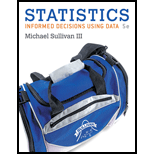
Concept explainers
(a)
To identify: The type of distribution.
The class width.
(b)
To identify: The type of experiment.
(c)
To explain: Whether the study is a prospective study.
(d)
To identify: The reason of urinalysis to measure the cotinine levels.
(e)
To identify: The explanatory variable.
To identify: The dependent variable.
To identify: Whether the independent variable is qualitative or quantitative.
To identify: Whether the response variable is qualitative or quantitative
(f)
To identify: The type of relationship between the variables.
(g)
The regression equation.
(h)
To interpret: The slope.
(i)
To interpret: The
(j)
To explain: Whether the model can be used for the provided situation.
(k)
To explain: The effect of smoking on the birth weight of the baby.
(l)
To identify: The lurking variable.
Want to see the full answer?
Check out a sample textbook solution
Chapter 4 Solutions
Statistics: Informed Decisions Using Data (5th Edition)
 MATLAB: An Introduction with ApplicationsStatisticsISBN:9781119256830Author:Amos GilatPublisher:John Wiley & Sons Inc
MATLAB: An Introduction with ApplicationsStatisticsISBN:9781119256830Author:Amos GilatPublisher:John Wiley & Sons Inc Probability and Statistics for Engineering and th...StatisticsISBN:9781305251809Author:Jay L. DevorePublisher:Cengage Learning
Probability and Statistics for Engineering and th...StatisticsISBN:9781305251809Author:Jay L. DevorePublisher:Cengage Learning Statistics for The Behavioral Sciences (MindTap C...StatisticsISBN:9781305504912Author:Frederick J Gravetter, Larry B. WallnauPublisher:Cengage Learning
Statistics for The Behavioral Sciences (MindTap C...StatisticsISBN:9781305504912Author:Frederick J Gravetter, Larry B. WallnauPublisher:Cengage Learning Elementary Statistics: Picturing the World (7th E...StatisticsISBN:9780134683416Author:Ron Larson, Betsy FarberPublisher:PEARSON
Elementary Statistics: Picturing the World (7th E...StatisticsISBN:9780134683416Author:Ron Larson, Betsy FarberPublisher:PEARSON The Basic Practice of StatisticsStatisticsISBN:9781319042578Author:David S. Moore, William I. Notz, Michael A. FlignerPublisher:W. H. Freeman
The Basic Practice of StatisticsStatisticsISBN:9781319042578Author:David S. Moore, William I. Notz, Michael A. FlignerPublisher:W. H. Freeman Introduction to the Practice of StatisticsStatisticsISBN:9781319013387Author:David S. Moore, George P. McCabe, Bruce A. CraigPublisher:W. H. Freeman
Introduction to the Practice of StatisticsStatisticsISBN:9781319013387Author:David S. Moore, George P. McCabe, Bruce A. CraigPublisher:W. H. Freeman





